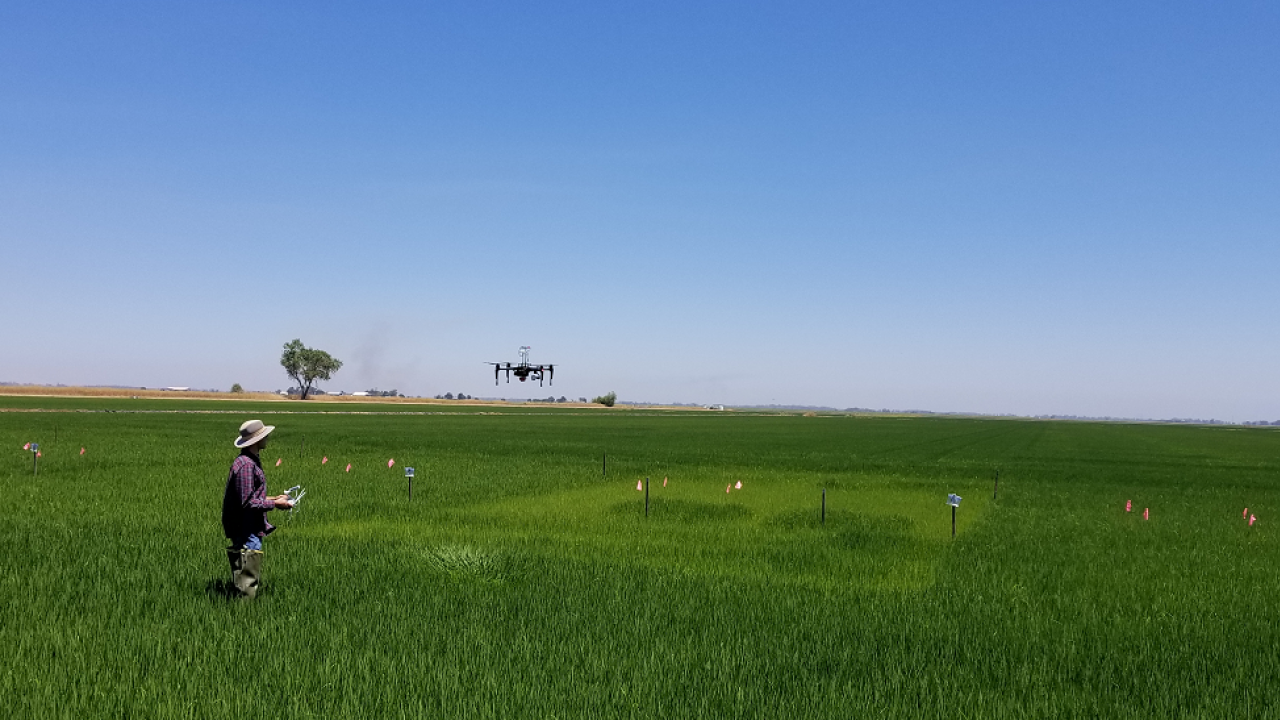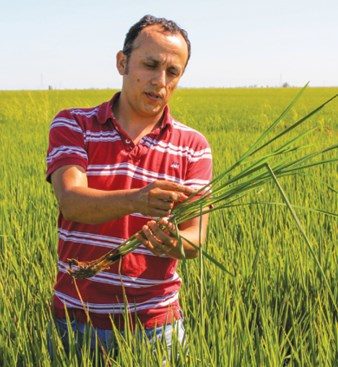
Drones help rice farmers hone fertilizer application and reduce crop fungal diseases
University of California rice researchers are exploring a more precise way of deciding whether the crop would benefit from a side-dress nitrogen fertilizer application, using drone-mounted cameras.
Hand-held Greenseeker-normalized difference vegetation index (NDVI) readings have already replaced color charts as a research tool for in-season fertilizer decisions, but drone photos of the normalized difference red edge index (NDRE) could take precision to an even higher level. [NDVI is the normalized difference vegetation index. NDRE is the normalized difference red edge index. Both are used to analyze remote sensing images and measurements on plants.]
“Do I need to apply top dress or not? I’ve been using the Greenseeker to answer this for years, but I am also looking at drones,” said Bruce Linquist, UC Cooperative Extension rice specialist and faculty member, Department of Plant Sciences, UC Davis. “The Greenseeker will give you the NDVI. A new one some people think might be more sensitive to nitrogen is the NDRE, which measures the red edge.”
Linquist made his remarks as he discussed fertilizer programs with the growers and pest control advisors at the 2019 Annual Rice Grower Meeting at Pheasant Hall south of Glenn.
As well as helping achieve the best yields, nitrogen management is also a key to reducing diseases like kernel smut and stem rot.
A current UC recommendation for deciding if a side dress application would help is to use the Greenseeker to calculate the ratio of the NDVI number for an extremely well fertilized strip and the number for the rest of the field.
“If your ratio is less than 1.1, you’re not likely to get a response to a top dress,” Linquist advised.
While this hand-held tool gives more reliable information than the old color charts, the drones may eventually provide the next generation of precision.
“The NDRE looks more sensitive to these higher nitrogen areas, and the drones could be useful with this,” Linquist said.
While a precise fertilizer program helps improve yields, it can also be one of the simplest tools for managing some important crop fungal diseases.
“The one factor that is very important is excess nitrogen,” said Luis Espino, UCCE farm advisor in Butte County. “The more nitrogen you have, the more smut you will have in your kernels. Stem rot is another disease that gets worse if you increase your nitrogen.”

Kernel smut has been in California rice fields for more than 30 years, but may be in an up cycle as a majority of the growers at the Pheasant Hall meeting, and more than 80 percent of those at an earlier Richvale meeting, have seen it in their fields.
“I’ve gotten quite a few questions and comments about kernel smut,” Espino said. “I hear from some growers and PCAs anecdotally that they think kernel smut has affected their yields. It definitely has an effect on milling yield.”
Studies from the southern U.S. and other rice-growing areas around the world indicate kernel smut can reduce yields as much as 15 percent.
There are effective fungicides, but unfortunately, by the time visible kernel smut symptoms appear it is too late.
“We have to base our decision about applying on the previous year, because there is nothing to see if you scout before heading,” Espino said.
The pathogens causing kernel smut have a life span within the field that goes back at least two years.
“Spores survive in the field, germinate in the field with primary spores, which create secondary spores that infect the crop,” Espino explained. “These chlamydospores are viable for two years, and can germinate after five months under water.”
Aside from good nitrogen management, there are also other preplant decisions that can reduce kernel smut in infested fields.
“The information we have from the southern U.S. and other parts of the world is that long grains are more susceptible than medium grains,” Espino said. “There are also seed treatments that prevent germination of the kernel smut spores.”
Research has shown infection is most likely to occur at the boot stage, and will be most intense when the temperature is moderate, between 77 and 86 degrees, and the field is humid.
The weather looks to have largely cooperated with rice production last season.
“In 2018, we had pretty much a normal season length and that is what we like to see,” Linquist said. “Last year, the USDA had us right at 500,000 acres; that was relatively good news. In 2017, we had a late plant and a normal harvest. Our season was shortened about a week and I think it affected our yield.”
Linquist said he expects the yield numbers for 2018 will be at least as high as 2017, and probably a little higher, but lower than 2015 and 2016.
One fly in the ointment, however, was the haze that filled the sky in the more northern growing areas during the Camp Fire.
“We had a dip in solar radiation during the fire, and I think that contributed to slightly lower yields,” Linquist said. “Overall, we had good harvest quality and very good grain quality.”
UC maintains a website showing five-year yield data for each of the six most widely planted rice varieties at 11 different locations.
The site has a map that lets growers and PCAs select a particular location and see how well different varieties performed in that area each of the last five years (rice.ucanr.edu).
(Article by Bob Johnson, mailto:bjohn11135@aol.com, and reprinted from AgAlert, California Farm Bureau Federation. Edits and additions by Ann Filmer, Plant Sciences, UC Davis; July 19, 2019.)
Additional information on rice fertilization from the Linquist lab:
- How to manage nitrogen fertilizer on rice when it rains during planting; May 2019.
- Technology for determining nitrogen applications in rice; February 2018.
- Proper phosphorus levels keep rice growing well; June 2016.
- Rice production and water efficiency; July 2015.
